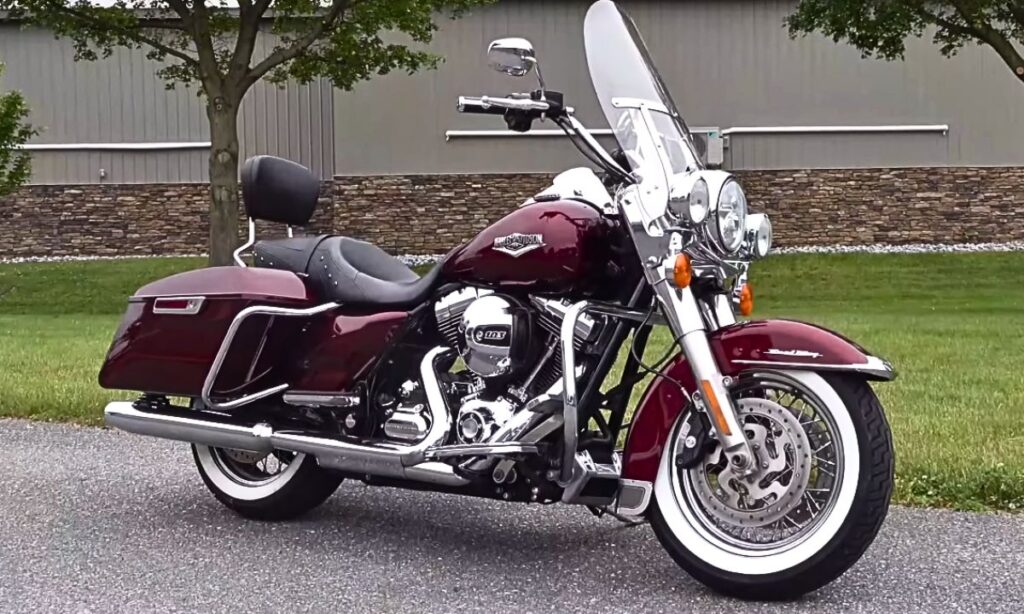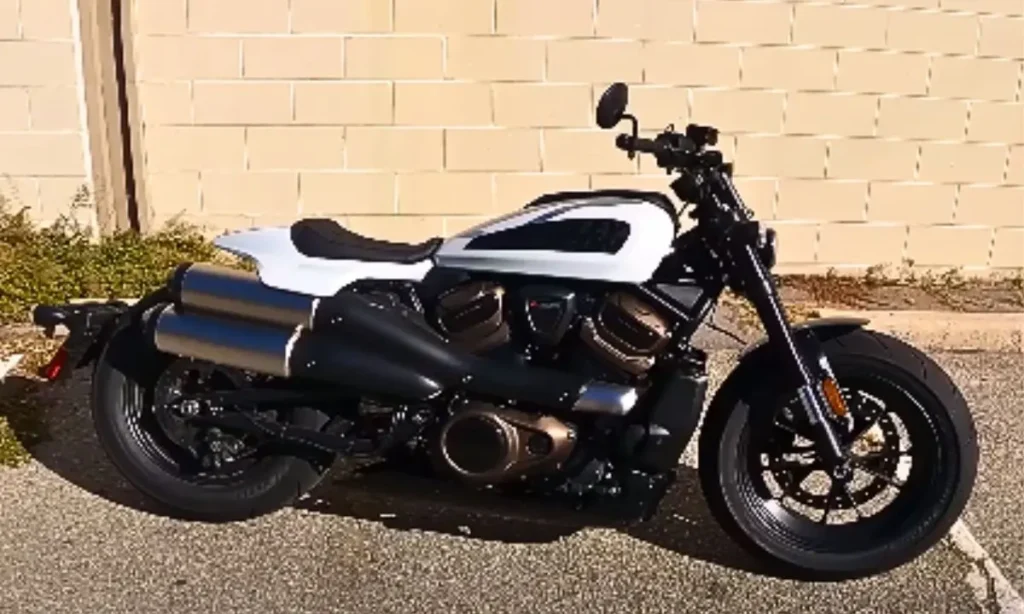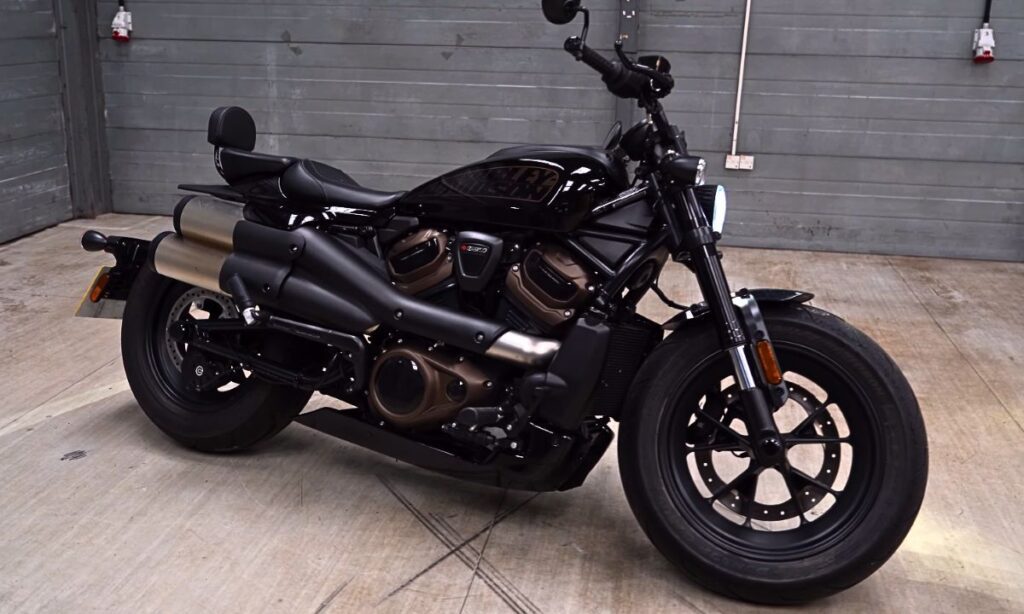The Harley Road King, a top model from the famous American motorcycle maker Harley-Davidson, has had its ups and downs over the years.
The Road King’s journey, full of history and personality, shows how it has been liked or disliked by motorcycle fans around the world.
In this article, we will explore the best and worst years of the Harley Road King, highlighting the factors that helped or hurt its success.
Road King Years To Avoid
The Harley-Davidson Road King is a popular motorcycle model known for its comfort, style, and performance.
However, there are certain model years that enthusiasts often recommend avoiding due to known issues.
The 2000, 2003, 2004, 2006, and 2004 Road Kings, for instance, were part of Harley and were noted for potential engine failures due to a design flaw in the cam chain tensioner.

1. Road King 2000
The year 2000 was a particularly problematic period for the Road King. This year’s model was plagued with several significant issues that make it a year to avoid when considering purchasing a used Road King.
One of the most notable problems was the cam chain tensioner. The original parts used in these models were prone to premature wear and tear, leading to catastrophic engine failure in extreme cases.
Furthermore, the 2000 Road King often suffered from subpar electrical systems.
Numerous owners faced recurrent issues related to ignition switch failures and faulty wiring, leading to unreliability and frequent breakdowns.
There were also widespread complaints about the motorcycle’s suspension, which many riders found to be overly stiff, resulting in uncomfortable rides.
Lastly, the build quality of the 2000 model was inconsistent at best.
Many owners reported excessive rusting on several chrome parts and the exhaust system despite regular upkeep.
2. Road King 2003
The model of 2003 has often been dubbed the worst year due to a multitude of issues that surfaced over the years.
Many of the riders noticed significant problems with the cam chain tensioner.
In this model, the tensioner shoes were made of a material that wore out prematurely, resulting in metal flakes dispersing into the oil and causing extensive engine damage.
Another major issue concern was with the fuel system. The 2003 model year carbureted system was notorious for gumming up if the motorcycle was not ridden regularly, leading to poor performance and necessitating expensive repairs.
This model was also known for its faulty wiring harness, which often led to short circuits, affecting the bike’s performance and rider safety.
Lastly, the brake system of the 2003 Road King was a cause for concern. Riders reported poor stopping power and a lack of responsiveness in emergency situations.
3. Road King 2004
The Road King model of 2004 is notorious among motorcycle enthusiasts and is often singled out as a year to avoid.
A principal reason is the defective cam chain tensioner. This component, made of plastic, was prone to rapid wear and tear, which could lead to catastrophic engine failure if left unattended.
The model year also suffered from frequent fuel system issues. The motorcycle’s EFI system was often problematic, leading to poor performance and fuel economy.
There were also instances of brake failure due to issues with the anti-lock brake system (ABS).
These significant shortcomings, combined, made the 2004 Road King a model year to steer clear of when considering a pre-owned Harley-Davidson motorcycle.
4. Road King 2006
A common issue reported by owners is the defective cam chain tensioner, which tends to wear out much earlier than expected, causing potential engine damage.
This problem is particularly noticeable in high-mileage motorcycles, leading to costly repairs if not addressed proactively.
Furthermore, the 2006 model has been plagued with a unique issue related to its fuel system.
The EFI system, which was newly introduced that year, has had numerous reported instances of malfunction, causing significant performance issues and reduced fuel economy.
This particular problem proved to be a major drawback, as the EFI was intended to improve fuel efficiency and overall performance.
Lastly, the brake system of the 2006 Road King was also called into question.
Numerous owners reported excessive wear and tear on the brake pads and rotors, requiring premature replacement.
These, coupled with the issues, made the 2006 model a troublesome year for the Road King.
5. Road King 2014
The 2014 Road King has been notorious in the motorcycle community and is often recommended to avoid. This is primarily due to a cascade of mechanical issues that plagued this model year.
A significant concern was the unreliable hydraulic clutch system, which had a tendency to fail unexpectedly, a potential safety risk.
The faulty clutch required frequent and expensive repairs, which frustrated the owners. The 2014 model year also suffered from problematic fuel systems.
Several owners reported that the motorcycle had issues with the fuel pump, leading to poor engine performance and occasional stalling.
This not only affected the bike’s rideability but also its long-term reliability. Lastly, the stock suspension components on the 2014 Road King were of subpar quality.
Riders frequently complained about a harsh ride, particularly on rough surfaces or long rides.
This resulted in an uncomfortable riding experience and extra costs for those who chose to upgrade the suspension for a smoother ride.
Overall, the 2014 Road King was marred by a series of significant issues that affected its performance, reliability, and overall riding experience.
Best Years For Harley Road King
The Harley Road King is an iconic motorcycle that has seen numerous iterations over the years.
However, enthusiasts often consider the early 2000s to be the best period for this model, particularly the 2002 Road King Classic.
This year saw the introduction of the fuel-injected Twin Cam 88 engine, which significantly improved the bike’s performance and reliability.
So here are the best years for the Harley Road King:
1. Road King 1999
The 1999 model represents a golden year in the model’s history, with specific attributes that endeared it to motorcycle enthusiasts.
This model features an 88 cubic inch displacement (TC-88) Twin Cam engine, revered for its power and reliability.
This engine, with its dual spark plugs per cylinder, provides a smooth, powerful ride, impressing with its performance on city roads and highways.
It also includes the classic large, detachable windshield and hard-shell saddlebags, offering convenience and practicality for long-distance rides.
The 1999 Road King’s design is an elegant fusion of modern technology with a traditional aesthetic, maintaining the iconic look Harley-Davidson is renowned for.
One of the notable features is its design, which isolates vibrations and reduces engine vibrations.
The Road King’s suspension system is also worth noting, providing a plush, responsive ride, absorbing bumps, and offering excellent handling, making the ride enjoyable and less strenuous.
It also boasts a remarkable fuel capacity of 5 gallons and an efficient fuel system, guaranteeing less frequent stops during your journey.
The 1999 Road King’s combination of power, comfort, style, and reliability is unmatched, making it a favorite among Harley-Davidson enthusiasts.
2. Road King 2002
The Road King 2002 model stands out as one of the best years for this classic motorcycle. This model, part of Harley’s FLHR series, is well-regarded for its superior performance.
The 2002 Road King comes equipped with a 1449cc Twin Cam 88 engine, providing a robust power output that you are sure to appreciate.
The engine, combined with a 5-speed transmission, ensures a smooth and powerful ride, living up to the high standards set by Harley-Davidson.
The bike also offers excellent fuel efficiency and a large fuel tank capacity, making it ideal for long journeys.
The 2002 model features a comfortable upright riding seat, wide handlebars, and a sizable windshield, all designed for a comfortable ride even over long distances.
The Road King 2002 has a classic, vintage look like other Harley-Davidson models. It has chrome accents and a traditional headlight design.
This model year is recognized for having fewer mechanical issues compared to other years, increasing its appeal to riders who value durability and low maintenance.
The Harley-Davidson Road King 2002 model, with its powerful performance, comfortable ride, vintage aesthetic, and enhanced reliability, remains one of the best years for this classic motorcycle.
3. Road King 2005
The 2005 Road King is renowned as one of the best years for this classic touring motorcycle due to its superior performance and reliability.
It is equipped with an air-cooled Twin Cam 88 engine that delivers an impressive torque of 86 ft-lb at 3500 rpm, providing you with exceptional power.
Its five-speed transmission is smooth and responsive, ensuring that riders enjoy a thrilling experience in various road conditions.
The 2005 Road King also stands out with its comfortable seating and adjustable rear air-shocks, which give excellent control and comfort during long rides.
Its classic tank-mounted speedometer and dual halogen headlamp add a timeless aesthetic appeal to the bike’s overall design.
One of the most appreciated features by riders is the detachable windshield, allowing for a more adaptable riding experience.
Whether you prefer the feel of the wind on your face or need protection from the elements.
However, the disc brakes on both wheels provide excellent stopping power for enhanced safety.
The 2005 Road King’s specs, combined with its appealing blend of classic and modern design elements, make it the top choice among the Harley lineup for many riders.
4. Road King 2016
The 2016 model is often hailed as one of the best iterations of this iconic motorcycle, known for its perfect blend of classic aesthetics and modern features.
It is powered by a High Output Twin Cam 103 engine, which delivers impressive torque, offering a dynamic and exhilarating riding experience.
The combination of its refined suspension system and air-adjustable rear shocks provides an exceptionally smooth ride, even on rough terrains.
The 2016 Road King is notable for its advanced technology, such as the standard electronic cruise control and the Reflex Linked Brakes with ABS for optimal braking power.
With a big saddlebag, it’s easy to carry what you need, which makes the motorcycle more useful.
The 2016 Road King has a classic design that appeals to traditional Harley enthusiasts, with features like timeless whitewall tires and a chrome headlamp nacelle.
Even though the Road King 2016 includes modern design touches like the smooth, easy-to-use saddlebag locks, it still appeals to many riders’ tastes.
The blend of classic and impressive power and features makes the 2016 Road King a favorite among motorcycle lovers.
Common Problems with Harley Road King
Just like any mechanical device, the Harley Road King can experience some common issues.
Here are some common issues that Harley Road King faces over time:
1. Engine and Motor Issues
One of the common issues with Road King motorcycles revolves around the engine and motor. Riders often report problems associated with overheating, oil leakage, and even complete engine failure.
Overheating may be due to a malfunctioning radiator fan or clogged coolant channels. Regular inspection and cleaning of the cooling system can help mitigate this issue.
Oil leakage, another prevalent problem, often arises from worn-out seals or gaskets. Paying attention to oil spots under the bike while it’s parked can help detect leaks early.
Replacing the faulty seals or gaskets can prevent potential engine damage. Complete engine failure, though less common, can be a critical issue.
It usually results from neglecting minor issues like overheating or oil leaks that escalate over time, leading to severe engine damage.
Regular maintenance, periodic oil changes, and checking for unusual noises or performance changes can avoid such catastrophic failures.
2. Transmission Issues
One of the common issues that Road King riders encounter is related to the transmission.
The transmission is responsible for controlling the power generated by the bike’s engine, so any problems can greatly affect the ride quality.
The riders have often reported transmission noise attributed to bearing failures. This typically manifests as a whining noise while the bike is in operation, particularly at higher speeds.
This is often coupled with difficulty shifting gears, a clear indicator of transmission issues.
Another key issue reported is the transmission fluid leak, which can lead to the transmission overheating. The symptoms can include less smooth gear changes and a burning smell.
Always regularly check the bike for any signs of leakage, particularly around the gasket area, and ensure that you perform regular oil changes to maintain the transmission’s health.
The transmission clutch can also cause problems, specifically the clutch not fully disengaging.
This often leads to the motorcycle stalling when it’s put into gear. The clutch cable adjustment, clutch shell bearing, or clutch hub could be at fault in these cases.
3. Faulty Fuel System
One common issue that Harley Road King owners encounter is a faulty fuel system.
This problem may manifest in several ways, such as poor engine performance, difficulty starting the motorcycle, or even stalling while in operation.
The Road King’s fuel system consists of several key components, including the fuel tank, fuel pump, fuel filter, and fuel injectors.
A problem in any of these areas can lead to a compromised fuel system.
A clogged fuel filter can restrict fuel flow, affecting engine performance. In this case, replacing the fuel filter is usually the solution.
If the issue lies with the fuel pump, the motorcycle may have trouble starting or might stall during operation. Solving this problem might require replacing the fuel pump.
When you’re dealing with fuel injectors, the build-up of deposits can cause them to function less effectively, often leading to poor fuel economy and engine performance.
A professional fuel injector cleaning can often resolve this issue.


Talha Younas, the brains behind the influential motorcycle-focused website, TwoWheller.com, is a dedicated and passionate advocate for biking culture. Born and raised in a family of motorcycle enthusiasts, his love for two-wheeled transportation was ignited at an early age. His commitment to providing in-depth reviews and helpful tips for riders has established him as a respected figure in the motorcycle community.

